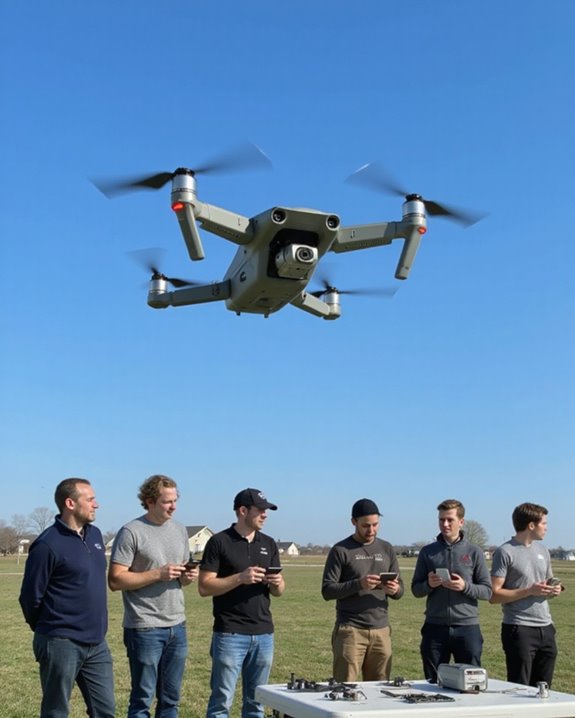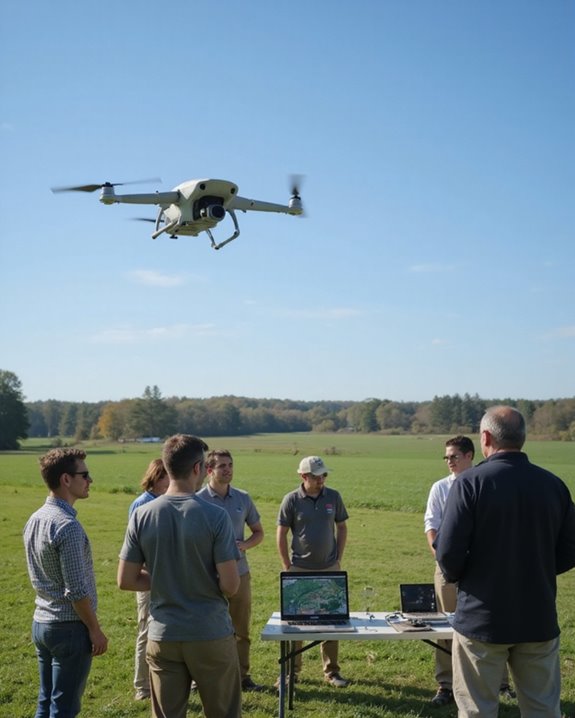A drone might be following you for all sorts of reasons—it could be a hobbyist’s gadget drifting by, a lost delivery drone, or a sneaky spy cam using high-tech tracking systems like GPS or even AI! Drones can use thermal cameras or clever tracking software to keep an eye on people, sometimes even by accident. Wondering if you’re really being watched? Strange buzzing, shadows overhead, or blinking lights could be a clue. Stick around to discover more fascinating signs and solutions!
Key Takeaways
- The drone may be using a “Follow Me” GPS mode to track a moving subject, either intentionally or due to a malfunction.
- Surveillance drones can autonomously follow targets using advanced AI, video analysis, and trajectory prediction technologies.
- Signal interference or GPS glitches can cause hobbyist or commercial drones to behave unpredictably and unintentionally follow people.
- Some drones are programmed for mapping or photography tasks that involve hovering near people or objects for data collection.
- There is a risk of privacy invasion if a drone is intentionally capturing video or images without consent or proper authorization.
Common Reasons Drones May Follow Individuals
Imagine glancing up and spotting a drone buzzing above—it’s easy to wonder, “Why is that thing following me?” Don’t panic just yet! There are plenty of harmless reasons for a drone’s curious flight path. Sometimes, it’s just hobbyist errors; maybe a new drone enthusiast is testing their latest gadget and accidentally trails a passerby while learning the controls. Small personal drones, often seen in parks or neighborhoods, can act unpredictably, especially in the hands of novices. Malfunction causes like signal interference or GPS glitches might send a drone drifting your way without warning. Even commercial drones, busy with mapping or real estate photography, can unintentionally hover near individuals. Most of the time, these flying machines are just victims of human error or simple technical hiccups! Additionally, many drones use a Follow Me GPS mode that actively tracks and follows a moving subject.
How Drones Track and Follow Moving Targets
When it comes to following moving targets, drones aren’t just buzzing around aimlessly—they’re actually putting some pretty advanced technology to work! High-tech tracking algorithms like TSFMTrack let drones lock onto a target and stick with it, even if the person or object tries to zigzag away. TSFMTrack uses a special Tracklet Filtering Module to “recognize” the look of what it’s following and a Tracklet Matching Module to keep tabs on it from frame to frame—think of it as a super-focused game of tag. Drones also use real-time video, image processing, and even micro-doppler radar to spot, locate, and predict where you might go next. With trajectory prediction, drones can guess your next move, making escapes a lot trickier! Some drones even incorporate Follow-Me mode to maintain smooth tracking of fast-moving targets up to 15 mph.
Technologies Enabling Drone Surveillance
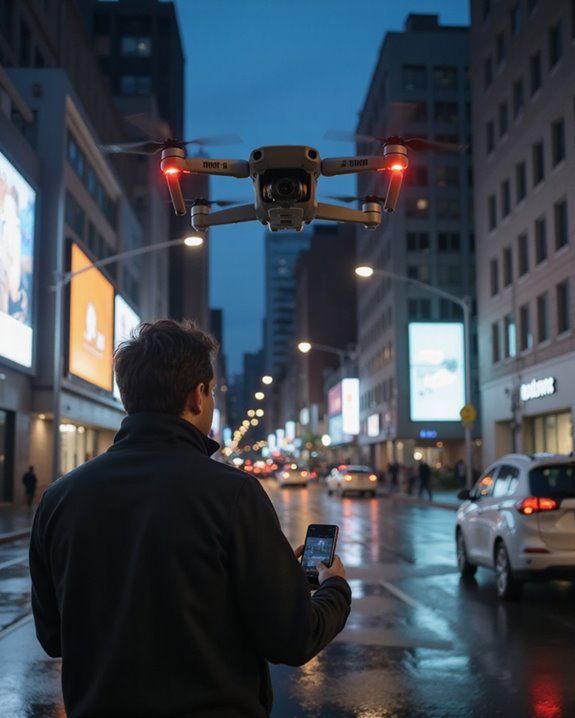
Tracking someone through a maze of streets or across a busy park might sound like spy-movie stuff, but today’s drones really have the tech to pull it off! Thanks to powerful AI Enhancements, drones can actually spot and follow people, cars, or even pets with surprising accuracy. Machine learning helps these flying robots spot “odd” behavior or changes, and they can change course all on their own—no joystick required! When it comes to Navigation Systems, drones use high-tech GPS, LiDAR, and obstacle sensors, so they don’t crash into trees or lampposts. Real-time video streams, sometimes with thermal cameras, beam straight to controllers. Coolest of all, drones can fly back to base if their battery’s low, like a very determined homing pigeon! Many advanced surveillance drones also include optical flow positioning to ensure stable and precise footage during flight.
Privacy Risks Associated With Drone Monitoring
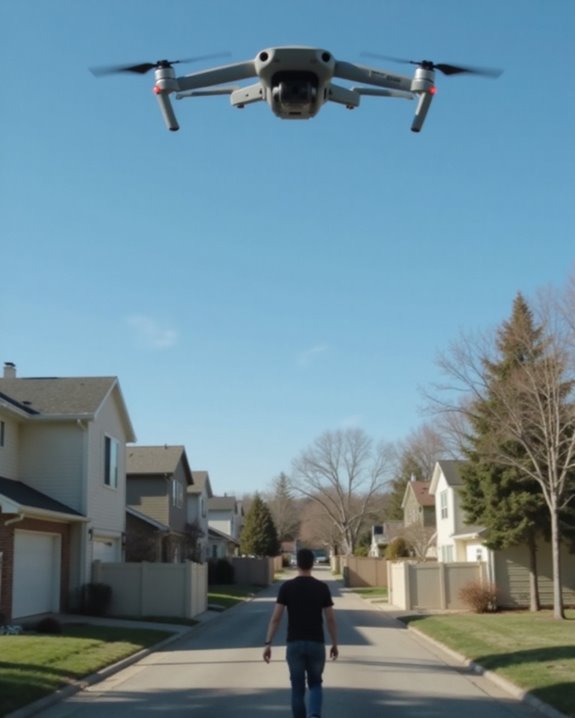
How would you feel if a buzzing drone hovered outside your bedroom window or zipped above your garden barbecue? It’s not just annoying—it’s a real privacy risk! Drones can quietly snap photos or record videos, slipping past fences and walls like privacy ninjas. This raises big ethical concerns: Who decides what’s okay to watch or record? The psychological impacts are serious too. Many people feel anxious or start acting differently when they think a drone is watching. Imagine censoring yourself in your own backyard! Drones can be hacked, making sensitive data vulnerable, and current laws struggle to keep up with this fast-paced technology. Whether it’s nosy neighbors, corporations, or even government agencies, unchecked drone monitoring could change how we experience privacy forever.
Signs You Are Being Monitored by a Drone
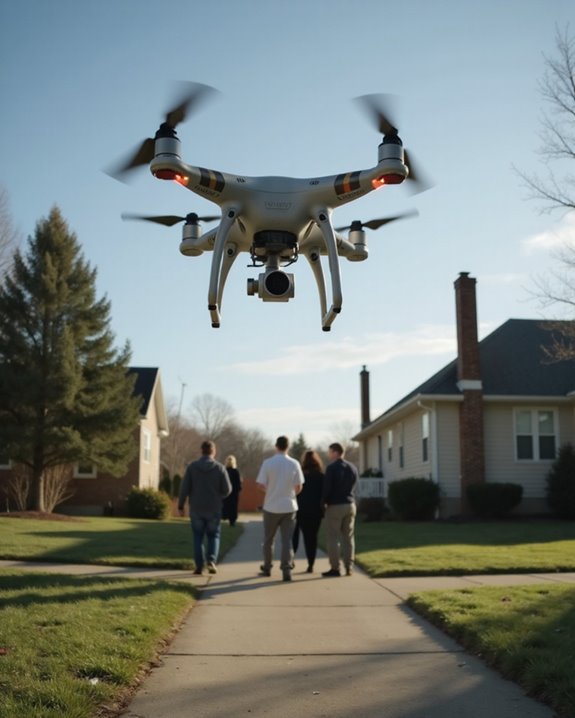
Ever wonder if that buzzing sound above your backyard isn’t just a curious bee? Sometimes, those mysterious buzzes are actually drones, quietly watching from above! Spotting Aerial Shadows moving across the lawn or catching a flash of lights at night can be telltale signs. Drones often have small LED lights, so if you see blinking in the sky, it’s probably not a firefly with high-tech dreams. Unexplained air traffic—like odd movements or hovering over a specific spot—should raise eyebrows. People also notice sudden interference with Wi-Fi or strange blips on their devices; RF signals from a drone can cause this. And if you ever spot a little machine with a camera, that’s a big clue you’re being monitored!
Legal Implications of Unauthorized Drone Activity
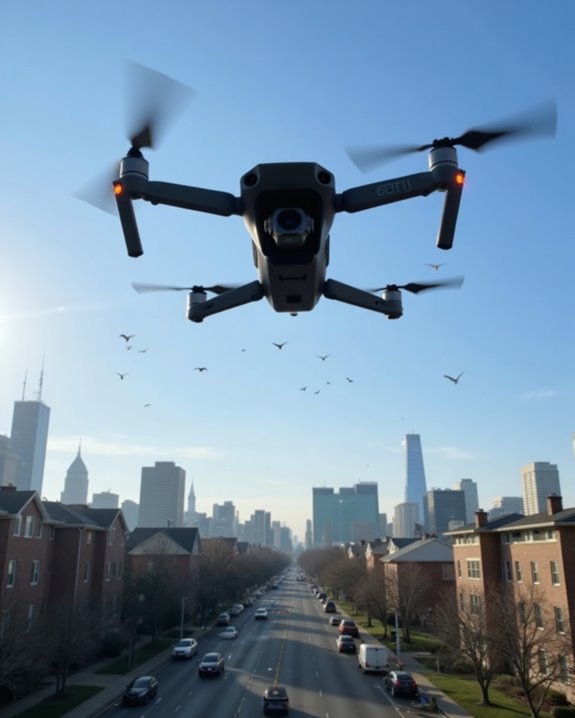
Although drones might seem like harmless high-tech toys zipping through the sky, there are serious legal issues that come into play when they’re used without permission. Drone Legislation is no joke—breaking the rules can lead to fines, license suspension, or even criminal charges. The Federal Aviation Administration (FAA) sets strict guidelines, but state laws add their own twists, sometimes increasing penalties for unauthorized flights. For example, flying a drone over someone’s backyard without consent can be trespassing, and capturing private moments might spark a civil lawsuit. Not only that, but recent Judicial Rulings have highlighted privacy concerns and set boundaries, especially when drones are used for surveillance. So, if you’re not following the law, you might find yourself in court—definitely not as fun as flying!
Methods to Detect and Identify Drones
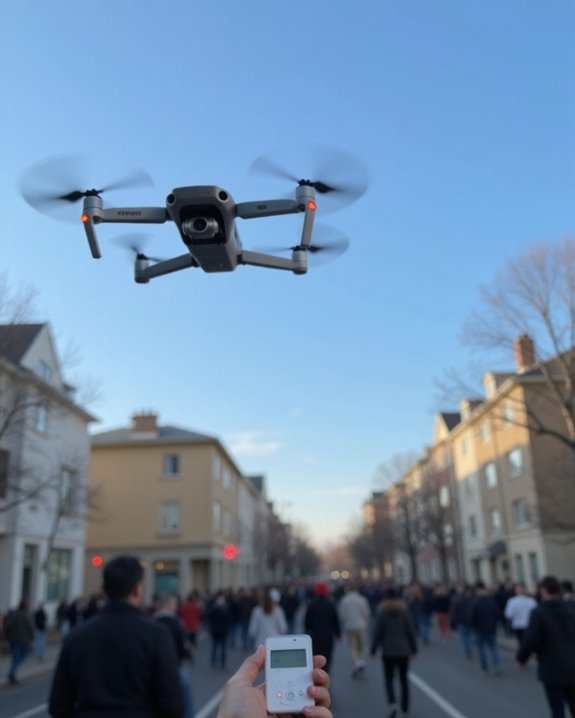
Spotting a drone in the sky might sound as simple as playing a high-tech game of “I Spy,” but in reality, detecting and identifying drones takes some impressive science and clever gadgets! Radar detection uses radio waves to scan the skies and spot flying objects—even tiny ones—by analyzing their reflection patterns. Radio Frequency (RF) detection listens for telltale signals between drones and their controllers, with clever Detection Algorithms distinguishing drones from background noise. Optical systems, like high-resolution and thermal cameras, let AI models visually confirm what’s buzzing above. Acoustic sensors add another layer by recognizing the unique whir of drone motors. The real magic happens with Sensor Fusion, where all these methods join forces, using machine learning to quickly and accurately identify drones—even the sneaky ones!
Steps to Protect Yourself From Unwanted Drone Surveillance
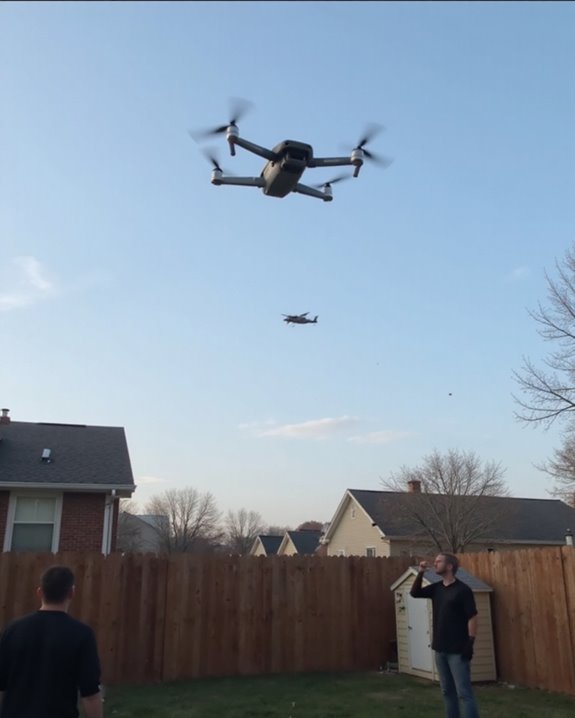
So, what can someone actually do if they suspect a drone is snooping where it shouldn’t? First, try Camouflage Strategies—hide under trees, near buildings, or even use big umbrellas (rain or shine, who’s judging?). Stay away from shiny surfaces; drones love a good glint! If the weather looks grim, use Weather Tactics: rain, fog, or high winds can ground most drones, so step outside only when Mother Nature’s got your back. Wearing anti-surveillance clothing or staying inside altogether helps, too. Build barriers—fences, walls, or mesh netting—to block a drone’s view. Know your legal rights: mark your land as a no-fly zone, set up alert systems, and report rogue drones to authorities. Remember, protecting privacy is everyone’s business!
Frequently Asked Questions
Can Drones Follow People Indoors or Through Buildings?
Drones can follow people indoors or through buildings using advanced Indoor Navigation and computer vision technologies. Building Obstacles and lack of GPS present challenges, but modern drones employ object recognition and obstacle avoidance to maintain tracking in complex environments.
How Long Can a Drone Follow Someone Before Its Battery Runs Out?
For example, a professional drone with high battery efficiency and energy savings technology, such as the DJI Matrice 300, can follow a target for about 55 minutes before its battery depletes, depending on flight conditions and payload.
Are There Specific Drone Models Known for Autonomous Following?
Certain drone models, such as those equipped with advanced following tech and AI-driven computer vision, are specifically designed for autonomous following. These drones can identify, track, and follow moving targets, supporting applications in security and research.
Can Weather Conditions Affect a Drone’S Ability to Follow Targets?
Weather conditions greatly impact a drone’s ability to follow targets. Wind stability is often compromised in strong gusts, and limited rain resistance can reduce sensor effectiveness, degrade image quality, and impair the overall tracking and navigation performance.
What Noises Do Drones Make When They’re Actively Tracking Someone?
Drone sounds can erupt into a cacophony of relentless whirring, layered with exaggerated tracking beeps and harmonic overtones. These persistent acoustic signatures, shaped by propeller speed and blade count, betray active surveillance, even amidst challenging environmental noise.


